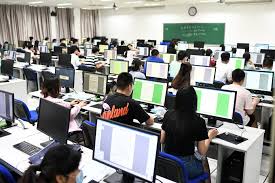- By - Destinyds
- Posted on
- Posted in Information Technology
Impacts of Business Technology
Impacts of Business Technology
Impacts of Business technology refers to the application of technology—tools, systems, software, and infrastructure—to help organizations achieve their business goals. It encompasses the integration of IT (Information Technology) into all aspects of a company’s operations to improve efficiency, productivity, decision-making, communication, and customer service.

1.Key Components of Business Technology:
- Hardware
Devices like computers, servers, mobile devices, and networking equipment used in day-to-day business operations.
-
Soft ware
Applications such as CRM (Customer Relationship Management), ERP (Enterprise Resource Planning), accounting systems, productivity tools, and industry-specific platforms. -
Networks and Infrastructure
Systems that enable communication and data sharing within and outside the organization—includes internet, intranet, and cloud services. -
Data Management and Analytics
Tools and techniques for collecting, storing, analyzing, and using data to drive informed business decisions. -
Cyber security
Measures and technologies used to protect business data and systems from cyber threats. -
Automation and AI
Technologies like robotic process automation (RPA), artificial intelligence, and machine learning that streamline tasks and enhance performance. -
Communication Tools
Platforms like email, video conferencing, chat apps, and collaboration suites that support internal and external communication.
2.Importance of Impacts of Business Technology:
-
Enhances efficiency and reduces operational costs
-
Enables scalability and flexibility
-
Improves customer experience
-
Supports strategic decision-making through data analytics
-
Provides a competitive edge through innovation
◊ Impacts of Business technology is the use of technology—such as software, hardware, and digital systems—to support, improve, and drive a company’s operations, processes, and goals. It helps businesses work more efficiently, communicate better, make smarter decisions, and serve customers effectively.
In simple terms:
- Impacts of Business technology is how businesses use tech tools to get work done faster, smarter, and better.

Examples include:
-
Email and messaging platforms for communication
-
Accounting and payroll software to manage finances
-
Customer Relationship Management (CRM) systems to track sales and customers
-
Cloud storage for data access from anywhere
-
Data analytics tools to understand market trends and customer behavior
Why it matters:
-
Increases efficiency and productivity
-
Helps businesses compete in fast-changing markets
-
Improves customer experience
-
Supports decision-making with accurate data
◊ The four main types of Impacts of businesses are classified based on ownership structure. Each type has different legal, financial, and operational implications:

1. Sole Proprietorship
-
Owned by: One individual
-
Control: Full control by the owner
-
Liability: Owner is personally liable for debts and obligations
-
Example: Freelancers, small retail shops, consultants
2. Partnership
-
Owned by: Two or more people
-
Control: Shared among partners
-
Liability: Usually personal liability for each partner, unless it’s a limited partnership
-
Example: Law firms, small businesses run by friends or family
3. Corporation (C Corp or S Corp)
-
Owned by: Shareholders
-
Control: Managed by a board of directors and officers
-
Liability: Limited liability — owners are not personally liable
-
Example: Apple, Microsoft, Coca-Cola
4. Limited Liability Company (LLC)
-
Owned by: One or more individuals or entities (called “members”)
-
Control: Flexible management structure
-
Liability: Limited liability protection like a corporation
-
Example: Small to medium-sized businesses across many industries
-
Impacts of business technology uses
- The study of business technology is an academic and practical field that focuses on how technology is used to improve and manage business operations, decision-making, and strategy.
- What It Involves:
- Studying business technology typically combines elements of:
- Information Technology (IT) – systems, networks, databases, and security
- Business Management – marketing, finance, operations, HR
- Digital Tools and Innovation – AI, cloud computing, data analytics, automation
- Strategic Thinking – aligning technology with business goals
Common Degrees or Courses:
Business Technology Management (BTM)
-
Information Systems
-
Management Information Systems (MIS)
-
Digital Business or E-Business
-
Technology and Innovation Management
Career Paths with Business Technology Knowledge:
- Business Analyst
- IT Project Manager
- Systems Analyst
- Technology Consultant
- Data Analyst
- Chief Information Officer (CIO)
- Technology is not a single type of business technology it can span multiple business types depending on how it’s structured and operated. However, when people refer to a “technology business,” they usually mean a company that develops, sells, or supports technology products or services.

◊ Common Types of Impacts of Businesses Technology:
Software Companies
Create apps, programs, and platforms (e.g., Microsoft, Adobe)
Can be service-based (SaaS), product-based, or both
Hardware Companies
Manufacture or sell physical tech products (e.g., Apple, Dell)
IT Services & Consulting in Impacts of Business Technology
- Provide support, development, or strategy services (e.g., Accenture, Infosys)
Tech Startups
Often focus on innovation, scalability, and rapid growth
Can be any legal structure: sole proprietorship, LLC, corporation
E-commerce & Internet Businesses
Platforms built on tech (e.g., Amazon, Shopify)
Telecommunications
Provide internet, data, and voice services (e.g., Verizon, AT&T)
Tech-Enabled Businesses
- Not purely tech, but heavily reliant on it (e.g., Uber, Airbnb)
- As of 2025, the salary for a Business Technology Analyst (BTA) at Deloitte India varies based on experience, location, and performance
- Impacts of Business Technology refers to the combination of technical tools, software, and processes that businesses use to manage and support their operations, data, communication, and decision-making.
- It involves integrated systems that connect different parts Impacts of Business Technology in of a business—like finance, HR, sales, and supply chain—into one streamlined technology framework.

Key Components of Impacts of Business Technology:
-
Enterprise Resource Planning (ERP) Systems
-
Integrate core business processes (e.g., SAP, Oracle, Microsoft Dynamics)
-
-
Customer Relationship Management (CRM) Systems
-
Manage customer data and interactions (e.g., Salesforce, Zoho CRM)
-
-
Accounting & Financial Systems
-
Automate billing, payroll, reporting (e.g., Quick Books, Tally)
-
-
Human Resource Management Systems (H R M S)
-
Handle hiring, payroll, performance, and compliance (e.g., Workday, Bamboo HR)
-
-
Supply Chain Management Systems
-
Oversee inventory, logistics, and procurement
-
-
Business Intelligence (BI) & Analytics Tools
-
Provide data-driven insights for decision-making (e.g., Power BI, Tableau Purpose of Business Systems Technology:
-
- Improve efficiency and automation
- Enable data integration and real-time reporting
- Support scalability as the business grows
- Ensure security and compliance

◊Help leaders make informed decisions:
- The Master of Business and Technology (MBT) is a graduate-level degree that blends business management principles with information technology knowledge. It prepares students to lead and manage technology-driven business environments.
◊What It Covers in Impacts of Business Technology
-
Business Fundamentals:
Finance, marketing, strategy, operations, leadership, and organizational behavior -
Technology Concepts:
IT management, systems analysis, data analytics, digital transformation, cyber security, and emerging technologies -
Integration:
How to align technology initiatives with business goals to drive innovation and competitive advantage -
Project & Change Management:
Skills to manage tech projects and organizational change effectively
◊Who Is It For?
-
Business professionals aiming to gain tech expertise
-
IT professionals wanting to develop management and business skills
-
Entrepreneurs and managers in tech-focused industries Career Opportunities After MBT:
-
Business Technology Manager
-
IT Project Manager
-
Digital Transformation Consultant
-
Business Analyst
-
Chief Technology Officer (CTO) (with experience)
-
Technology Strategy Consultant
3.Typical Program Duration:
1 to 2 years (full-time or part-time)
Core Focus Areas:
-
Business Information Systems
-
Study of systems that collect, process, and distribute information to support business decision-making.
-
-
Digital Transformation
-
How businesses adapt and innovate using digital technologies to improve operations and customer experience.
-
-
E-commerce and Online Business in Impacts of Business Technology
-
Using internet technologies to buy, sell, and market products or services.
-
-
Enterprise Technologies
-
Tools like ERP, CRM, and supply chain systems that integrate business processes.
-
-
Data Analytics and Business Intelligence
-
Using data to make strategic business decisions.
-
-
Cybersecurity
-
Protecting business information and assets from digital threats.
-
-
Innovation and Emerging Technologies
-
Exploring AI, blockchain, IoT, cloud computing, and their business applications.
-

4.Why It’s Important in Impacts of Business Technology
-
Enables businesses to operate more efficiently and compete in the digital economy
-
Supports data-driven decision-making and customer engagement
-
Helps businesses innovate products, services, and business models
◊ In Academia: Courses or modules on Impacts of business Technology in Business are commonly found in business,management, information systems, or technology programs, often under titles like:
- Business Information Technology
- Management Information Systems (MIS)
- Digital Business
- Technology Management
◊ The role of Impacts of business technology is to enable, support, and transform how companies operate,compete, and deliver value. It is a core driver of efficiency, innovation, growth, and strategic decision-making in modern organizations.
5.Key Roles of Impacts of Business Technology:
1. Improving Efficiency and Productivity
-
Automates routine tasks (e.g., payroll, inventory management)
-
Speeds up communication and workflows
-
Reduces errors and manual work
2. Enhancing Communication
-
Tools like email, video conferencing, messaging apps, and collaboration platforms enable faster and clearer communication
-
Supports remote work and global teamwork
3. Data Management and Decision-Making in Impacts of Business Technology
-
Collects, stores, and analyzes data to guide strategic choices
-
Business intelligence tools provide real-time insights
4. Innovation and Product Development
-
Enables faster development of new products/services (e.g., using AI, IoT, or cloud computing)
-
Helps businesses respond quickly to market changes
5. Improving Customer Experience
-
Personalizes services through CRM systems and AI-powered platforms
-
Enhances support via chat bots, help desks, and mobile apps
6. Enabling Digital Marketing
-
Uses online channels (social media, SEO, email marketing) to reach and engage customers
-
Tracks campaign effectiveness with analytics tools
7. Ensuring Security and Compliance
-
Protects sensitive data through cyber security measures
-
Helps meet legal and industry regulations with automated compliance systems
6.Real-World Examples:
- Amazon using AI for product recommendations and supply chain optimization
- Small businesses using cloud tools like Google Workspace or Microsoft 365
- Banks using mobile apps, online banking, and bio-metric authentication
- The concept of Impacts of business technology refers to the strategic use of technology to support and enhance a company’s operations, goals, and value creation. It is about aligning technological tools and systems with business needs to improve performance, innovation, and competitiveness.

◊Core Idea in Impacts of Business Technology:
-
Impacts of Business technology is the integration of digital tools—hardware, software, data, and systems—into business strategies and processes to drive efficiency, innovation, and value.
- Key Elements of the Concept:
-
Technology as a Business Enabler
-
Technology is not just a support function; it drives growth, agility, and decision-making.
-
Example: Using data analytics to predict market trends.
-
-
Cross-Functional Integration
-
Business technology connects departments like finance, HR, sales, and operations through integrated systems (e.g., ERP, CRM).
-
-
Digital Transformation
-
Embraces new tech (like cloud computing, AI, automation) to re-imagine how business is done.
-
-
Customer-Centric Innovation
-
Enhances customer experience using digital tools (e.g., personalized apps, online platforms, chat bots).
-
-
Strategic Alignment
- Ensures that IT goals support overall business strategy, not operate in isolation.
◊Examples of Impacts of Business Technology in Action:
-
E-commerce platforms (Amazon, Shopify)
-
Business intelligence dashboards (Power BI, Tableau)
-
Cloud collaboration tools (Google Workspace, Microsoft 365)
-
Cyber security solutions (firewalls, encryption tools)
- Why It Matters:
- Improves operational efficiency
- Supports better decision-making
- Enables scalability and adaptability
- Fosters innovation and market responsiveness


